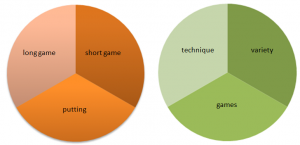Rule of Thirds
 Practicing serves one primary purpose: to improve your competitive performance. You need to ensure you are doing whatever you can to be able to transfer your improvement to the course.
Practicing serves one primary purpose: to improve your competitive performance. You need to ensure you are doing whatever you can to be able to transfer your improvement to the course.
You must also create balance in your practice plan to ensure you are devoting sufficient time to each area of your game.
One way to achieve a balance in your practice is to be mindful of how your shots are distributed on the course. Statistically, approximately 40% of your shots will be full shots, 40% will be putts and 20% will be short game shots. Given the variety of short game shots: chips, pitches and bunker shots, it is fairer to spend 1/3 of your time on your long game, 1/3 on your short game and 1/3 on putting. Nice and easy to remember.
How you sub-divide that time is also crucial. Many players practice only technique when they are hitting full shots on the driving range. While there may be a short-term benefit in the quality of ball striking, there is usually difficulty in taking this improved form to the golf course, particularly under pressure.
To enable a transfer of form from the range to the course, you will need to add variety to your practice and also to create some pressure when you are hitting your shots. For full shots, variety can mean changing the club you are using, your target, shot shape or trajectory, or effort level.
To create pressure and test how robust your skills are, you can carry out competitive drills and games with a scoring system attached to them.
So how much time should be devoted to technique, variety and skill testing?..one third of your time for each. When you are putting, spend 1/3 on putting technique, such as stroke path or stroke pace; 1/3 of your time on variety, such as green reading or long putting; and 1/3 of your time on skill testing, such as hitting 10 balls from 1 metre at different points around the hole and then hitting a further 10 balls from 2 metres.
When you first adopt the Rule of Thirds to your practice, you are likely to complete the technical part of your session and want to spend just a little more time on it because you have just about got the swing feel you are after or you want to groove a good shot. When this happens, usually the entire time passes without doing anything other than working on technique. I have seen this countless times. The result is very little balance in your practicing, which is reflected on the course.
Practicing according to the Rule of Thirds, which means adding variety and skills testing to the your practice sessions will create a far better transfer to the course and lead you to becoming a much better golfer in the long run.
Give it a try this month and notice the benefits.
